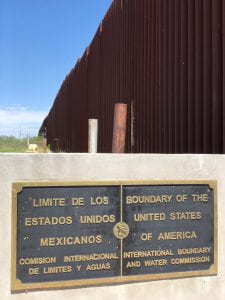: Collaborative research
: INFORMATION, TECHNOLOGY AND MIGRATION
uses of ICT at the US-Mexico Border
IN THE LAST TWO DECADES, thousands of undocumented immigrants have died while attempting to cross the international border between the United States and Mexico. Prior research indicates a causal link between the U.S. government’s border control policies and rapidly increasing numbers of migrant deaths. In response, a variety of humanitarian organizations and volunteers have been leaving food, water, and clothing in small caches along the migratory trails.
The current project explores three key areas at the intersection of information, technology, national security, illegal immigration, law, and philosophical ethics:
(1) what are the information needs and practices of irregular migrants at the US-Mexico border;
(2) what are the motivations, and the information needs and practices of humanitarian organizations working with migrants at the US-Mexico border; and
(3) how can humanitarian information activities be strengthened to better protect the privacy of vulnerable populations such as undocumented migrants.
results
These are some of the publications that have resulted from this and related work to date:
Published:
Gomez, R., Vannini, S., & Newell, B. (2020). Mind the Five Card game: Participatory games to strengthen information practices and privacy protections of migrants, International Journal of Information, Diversity & Inclusion. 4(2), 116-122. Toronto, ON: University of Toronto Faculty of Information. Link
(2020) The information practices and politics of migrant-aid work in the US-Mexico borderlands, The Information Society, DOI: 10.1080/01972243.2020.1761918
Gomez, R., Newell, B., & Vannini, S. (2020). Empathic Humanitarianism: Understanding the motivations behind humanitarian work with migrants at the US-Mexico border, Journal on Migration and Human Security JMHS. Sage.
Vannini, S., Gomez, R., Lopez, D., Mora, S., Morrison, J. C., Tanner, J., Youkhana, L., Vergara, G., & Moreno Tafurt, M. (2020). Humanitarian organizations’ information practices: Procedures and privacy concerns for serving the undocumented, Electronic Journal of Information Systems in Developing Countries EJISDC, 86(1), 8p. Wiley. Link
Vannini, S., Gomez, R., & Newell, B. (2019). Documenting the Undocumented: Privacy and Security Guidelines for Humanitarian Work with Irregular Migrants. Proceedings of iConference 2019.
Vannini, S., & Gomez, R. (2019). Participatory Photography To Elicit Lived Experiences With Undocumented Migrants And Humanitarian Organizations. Association for Borderlands Studies Conference 2019.
Vannini, S., Gomez, R., & Newell, B. (2019). Privacy and Security Guidelines for Humanitarian Work with Undocumented Migrants. Proceedings of ICTD 2019. (paper) (poster)
Newell, B., Vannini, S., Gomez, R., & Nemer, D. (2018). Exacerbating the Vulnerabilities of Undocumented Migrants: The Risks Involved in the Humanitarian Information Activities of Migrant-Aid Organizations. proceedings of iConference 2018.
Gomez, R. (2018). Ni aquí ni allá: Nociones de hogar y sentido de pertenencia en el contexto de la migración, Anuario Electrónico de estudios en Comunicación Social “Disertaciones”, 11(1), 169-194. Bogota: Universidad del Rosario. Link
Vannini, S., Gomez, R., Carney, M., & Mitchell, K. (2018). Interdisciplinary approaches to refugee and migration studies: Lessons from collaborative research on sanctuary in the changing times of Trump, Migration and Society, 1(1). Link
Gomez, R., & Vannini, S. (2017). Notions of home and sense of belonging in the context of migration in a journey through participatory photography, Electronic Journal of Information Systems in Developing Countries (EJISDC), 78(1). Link
Gomez, R. (2017). Raíces y ramas al viento: experiencias colombianas de migración y prácticas de información, Revista CS en Ciencias Sociales,(22), 33-53. Cali: Universidad Icesi. Link
Gomez, R. (2017). Vulnerabilidad y prácticas de información: experiencias de migrantes latinos (indocumentados) en EE.UU., Revista CS en Ciencias Sociales,(20), 93-121. Cali: Universidad Icesi. Link
Newell, B., Gomez, R., & Guajardo, V. (2017). Sensors, Cameras, and the New ‘Normal’ in Clandestine Migration: How Undocumented Migrants Experience Surveillance at the U.S.-Mexico Border, Surveillance and Society, 15(1). Link
Carney, M., Gomez, R., Mitchell, K., & Vannini, S. (2017). Sanctuary Planet: A Global Sanctuary Movement for the Time of Trump, Society and Space. SAGE. Link
Gomez, R. (2016). Vulnerability and information practices among (undocumented) Latino Migrants, Electronic Journal of Information Systems in Developing Countries (EJISDC), 75(1), 1-43. Link
Newell, B., Gomez, R., & Guajardo, V. (2016). Information Seeking, Technology Use, and Vulnerability among Migrants at the U.S.-Mexico Border, The Information Society, 32(3), 176-191. Routledge. Link
Baron, L. F., Neils, M., & Gomez, R. (2014). Crossing new borders: computers, mobile phones, transportation and English language among Hispanic day laborers in Seattle, JASIST – Journal of the American Society for Information Science and Technology, 65(1), 98-108. Wiley. Link
Related Project WebSites
Blog posts
Gomez, R., Newell, B.C., & Vannini, S. (2021). Motivations to do humanitarian work with immigrants: lessons from the US-Mexico Border. Sage Perspectives, Editor’s picks.
Carney, M & Gomez, R. (July 2018): Now That Family Separations Have Got Your Attention… Human Centered-Computing Across Borders HCCxB, Medium.
Vannini, S. & Gomez, R. (June 2018): We need Digital Sanctuaries across Borders. Human Centered-Computing Across Borders HCCxB, Medium.
Newell, B. (August 2014):Facebook Savvy Migrants? Research Notes from the U.S.-Mexico Border. The Information, Information School, University of Washington.
Gomez, R. (May 2014): Fotohistorias de la Frontera: No es un crimen querer trabajar. Caracoli del Cesar, Colombia.

Humanitarian volunteers leave water in the desert to help prevent more migrants from dying in the US-Mexico border.
Collaborators
Ricardo gomez
University of Washington
Information School
sara vannini
Sheffield University
Information School
bryce c newell
University of Oregon
School of Journalism and Communication




